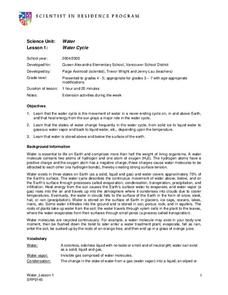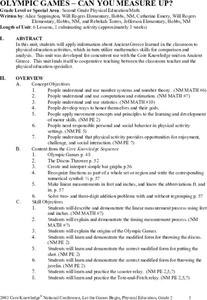Curated OER
Line With Printmaking
Third graders investigate the use of lines in different pieces of art by creating their own ink print. In this art analysis lesson, 3rd graders identify the contours and lines of natural objects such as twigs and leaves. Students trace...
Curated OER
Measure Up!
Discover ways to measure items without standard tools. In this measurements lesson, learners estimate how long certain objects are by measuring with a non-standard measuring tool. Young scholars check their estimates with a ruler and...
Curated OER
Water Cycle
Young scientists explore Earth elements by conducting an experiment. They define water vocabulary terms such as condensation and precipitation. In addition, they conduct a water experiment in which they build a terrarium, so they can...
Curated OER
Addition and Subtraction Fact Family Lesson Plans
Get more bang for your buck by teaching addition and subtraction fact family lesson plans.
Curated OER
Area and Perimeter Activities
Read this article before you begin teaching geometry! It gives teachers some insight into the world of teaching geometry to young learners, and four area and perimeter lessons are attached.
Curated OER
Making Sense of Dollars and Cents
Teaching the money system to youngsters through games, literature, and real-world simulations
New York City Department of Education
Egypt
This six-week unit encompasses all subjects with a focus study on world history and the development of ancient civilizations. As gifted and talented students dive into the interesting yet challenging topic of Egypt, they think critically...
Baylor College
Modeling Earth's Atmosphere
Life on Earth is made possible by the unique composition of its atmosphere. Working collaboratively, a scale model is created as young scientists learn about the different layers of gas that surround the planet. Cards are included that...
SurfScore
Kodable
Prepare young scholars for life in the twenty-first century with this introduction to computer coding formatted as a fun problem solving game, this resource is a great way to develop children's sequential thinking skills.
Cornell University
Non-Newtonian Fluids—How Slow Can You Go?
Children enjoy playing with silly putty, but it provides more than just fun. Young scientists make their own silly putty using different recipes. After a bit of fun, they test and graph the viscosity of each.
Curated OER
Olympic Games - Can You Measure Up?
Students complete 6 units to learn about Ancient Greece and the Olympic games through physical education activities as well as math activities. In this Ancient Greece lesson, students complete multiple activities in 6 lessons including...
Curated OER
Multiplication Algorithm (1)
Third graders in a 3rd grade math class make connections from prior instruction and mastery to solve problems in new learning situations. Using logical thinking and prior knowledge to solve current math problems is the focus of this...
Curated OER
Canada Calendar Pieces- Leaves and Fireworks
In this math worksheet, students cut out 31 calendar pieces to make a calendar or bulletin board display. The pieces have the numbers from 1 to 31 and designs with fireworks and the Canadian maple leaf.
Curated OER
Little Pigs with Big Problems
First graders solve one problem per day regarding the story of Three Little Pigs. In this math journals lesson plan, 1st graders solve problems on a daily basis using the story of the Three Little Pigs.
Curated OER
Island Hopping
Students to use cooperation, communication, problem solving, and math skills.
Other popular searches
- Elementary Math Lessons
- Elementary Math Patterns
- Elementary Math Worksheets
- Elementary Math Survey
- Elementary Math Addition
- Elementary Math Assessments
- Elementary Math Lesson Plans
- Math Table. Elementary Math
- Elementary Math Tests
- Elementary Math Survey\
- Elementary Math Survey Bias
- Math Table Elementary Math

















